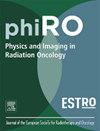Adaptive treatment workflow and dosimetric evaluation of intracranial fractionated stereotactic radiosurgery on a low-field magnetic resonance-linear accelerator
IF 3.4
Q2 ONCOLOGY
引用次数: 0
Abstract
Background and Purpose
Online adaptive radiotherapy for fractionated intracranial stereotactic radiosurgery (FSRS) on a magnetic resonance linear accelerator (MR-L) has the potential to allow for real-time adjustments of anatomical changes during radiotherapy treatment. This study investigates the dosimetric improvements of an online-adaptive MR-L workflow and validates the dosimetry utilizing an MR-visible phantom.
Methods and materials
Twenty-six cases previously treated with a conventional C-arm linear accelerator (CA-L) were replanned to determine optimal optimization constraints and objectives for achieving comparable MR-L plans. The optimization methodology was subsequently applied to simulate an online adaptive workflow on an MR phantom, incorporating target volumes from five previously treated patients that required offline adaptation. Plan quality and normal brain dose statistics were evaluated and compared to the offline adapted CA-L plans.
Results
No significant difference was observed between the CA-L and MR-L target coverage. The normal brain dose for MR-L plans increased with target volume more rapidly than for CA-L plans. However, some outliers achieved equivalent normal brain doses, indicating potential benefits of MRIgRT for specific superficial volumes located in the frontal, occipital lobes, and cerebellum. End-to-end validation with simulated adaptive workflow on a MR phantom utilizing target volumes that previously required adaption showed acceptable difference of <2.5 % between measured and planned target dose.
Conclusion
The study shows promising results for an online adaptive workflow for the treatment of intracranial FSRS on a low-field MR-L.
在低场磁共振线性加速器上进行颅内分形立体定向放射手术的自适应治疗流程和剂量学评价
背景和目的在磁共振直线加速器(MR-L)上对分形颅内立体定向放射外科(FSRS)进行在线自适应放疗,有可能在放疗过程中实时调整解剖变化。本研究探讨了在线自适应MR-L工作流程的剂量学改进,并利用mr可见幻影验证了剂量学。方法和材料对26例先前使用常规c臂直线加速器(CA-L)治疗的病例进行重新规划,以确定实现可比较的MR-L计划的最佳优化约束和目标。随后,该优化方法被应用于模拟MR幻影的在线自适应工作流程,其中包括来自5名需要离线适应的先前治疗患者的靶体积。评估计划质量和正常脑剂量统计数据,并与离线适应CA-L计划进行比较。结果CA-L与MR-L的靶覆盖率无显著差异。与CA-L计划相比,MR-L计划的正常脑剂量随靶体积增加的速度更快。然而,一些异常值达到了相当的正常脑剂量,表明MRIgRT对位于额叶、枕叶和小脑的特定浅表体积的潜在益处。利用先前需要适应的靶体积,在MR幻影上模拟自适应工作流程进行端到端验证,结果显示测量和计划目标剂量之间的可接受差异为2.5%。结论本研究为低场磁共振成像治疗颅内FSRS的在线自适应工作流程提供了良好的结果。
本文章由计算机程序翻译,如有差异,请以英文原文为准。
求助全文
约1分钟内获得全文
求助全文
来源期刊

Physics and Imaging in Radiation Oncology
Physics and Astronomy-Radiation
CiteScore
5.30
自引率
18.90%
发文量
93
审稿时长
6 weeks
 求助内容:
求助内容: 应助结果提醒方式:
应助结果提醒方式:


